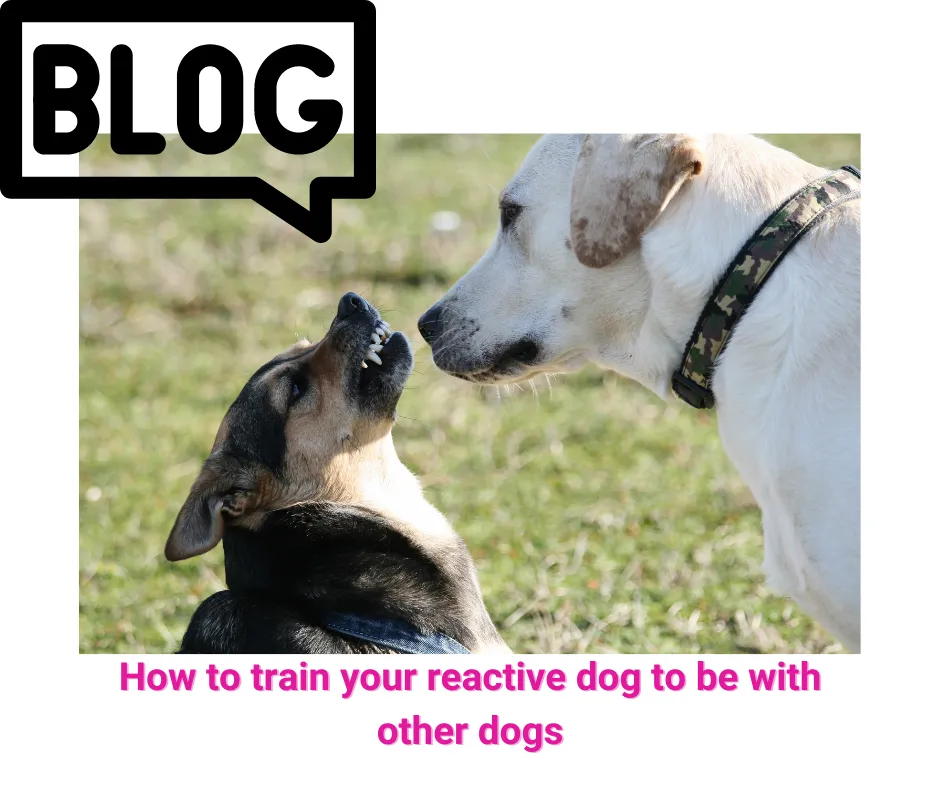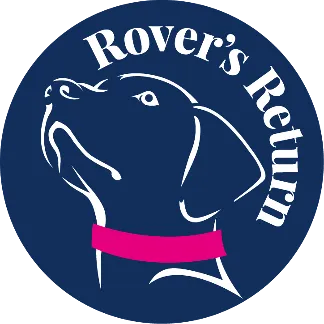Book a FREE 1:1 Assessment Call By Clicking HERE
Specialising In Dog Reactive Behviour
Accredited by APDT, ABTC and UK DOG Behaviour and Training Charter
Qualified and Experienced
Force Free Trainer and Behaviourist
Dog Training Leicestershire Educational Blogs

How to train your reactive dog to be with other dogs
“I have been studying dog behaviour for the last eight years. I specialise in reactive behaviour. Almost all of my clients talk to me about their dogs socialising with other dogs to get them used to other dogs so they do not react.” - Sam Hughes
How to train your reactive dog to be with other dogs
Dogs are social animals and you expect your dog to be friends with every person and dog. But sometimes dogs show adverse behaviours toward other dogs.
Walking your reactive dog is stressful. You worry about what people think of you and your dog because you know them as a lovely happy dog, it’s just when they see another dog they turn into a wild animal.
When out walking you try to avoid people with dogs so your dog doesn’t react, but people don’t always control their dogs, then blame you, when it is their fault!
Have you thought that your dog's reactive behaviour is ruining your family's lives? You want to enjoy long, leisurely walks with friends, let them play with other dogs and sit in a cafe enjoying a coffee with friends. But the reality is very different. As soon as your dog sees another dog they begin barking and lunging and you find yourself having to drag them away.
It seems hopeless. It isn’t and it is never too late for you to train your reactive dog to be able to interact with other dogs.
It can be frustrating when your dog seemingly suddenly becomes reactive for no reason, however, it is important to understand why your dog is behaving that way and how to help them not to react.
I have been studying dog behaviour for the last eight years. I specialise in reactive behaviour. Almost all of my clients talk to me about their dogs socialising with other dogs to get them used to other dogs so they do not react.
This is the last thing that you should do.
Read on to find out more.

How To Socialise My Reactive Dog
It’s your fault that your dog is reactive. Have you thought that? Dogs become reactive for several reasons and a lack of effective socialisation could be part of this, however, there are many other factors to take into account. A popular opinion is to get your dog out and about and get them used to being with other dogs. It is not your fault.
If your dog is reactive to the sight of another dog, then placing them in situations where other dogs are isn’t helping them. And ‘socialising your dog’ isn’t going to cure their reactivity.
The best way that you can help your dog to socialise with other dogs is to give them the space that they need away from the triggers that spark adverse behavioural responses.
This helps prevent rehearsing the behaviour, each time they do this, it keeps them safe and the brain stores it as a success and will repeat the same behaviour next time. By desensitising and counter-conditioning their responses you can change behaviour. Work on focus and disengagement, away from triggers before gradual exposure, at the dog's pace will allow them to be more confident.
Why Is My Dog Suddenly Reactive To Other Dogs?
There are many reasons why your dog behaves the way that they do. Sudden reactivity without warning can be due to pain or illness. If your dog suddenly becomes reactive, it would be a good idea to check for pain, and illness as this is a major trigger for reactive behaviour. Animals often hide pain, it’s part of the survival instinct. If it continues after these have been ruled out it is likely that the situation that they are in is too stressful and the behaviour is communicating this to you.
Reactivity grows. It is unlikely that reactivity will disappear without intervention.
If reactive behaviour continues to happen and increases in intensity it is a little more serious and you should take action to help your dog be calmer and not react.
Behaviour happens because it works for the dog to keep them safe and protected.
Their behaviour occurs because they feel threatened, frustrated, excited or conflicted.
If the behaviour didn’t work, the brain would drive another behaviour until it worked to keep them protected.
Dogs do not act for no reason. Every behaviour is for a specific reason, even if you don’t understand what that reason is.
My Dog Is Reactive When On Their Lead But They Are Ok When Off Their Lead.
The lead takes away the freedom to move away should the dog need to. They become very aware of this early on. This can be an issue for many dogs.
We put tension on the lead when walking, without realising. Your dog feels this tension from you. Even when walking and there is no tension if you are feeling stressed your dog is aware.
Tension on the lead leads to a reflex stress response. Dogs rehearse these behaviours so often that they become a pattern.
When off lead the tension and stress aren’t there. Your dog will feel more relaxed and the option to flee is there should they need it.
The fight or flight response is the body's way of coping with stress.
When faced with situations that are threatening or stressful the brain triggers a reflex response driven by the amygdala (responsible for emotional behaviour), and hypothalamus (influences the endocrine system) triggering the autonomic nervous system to produce the hormones adrenalin and cortisol to burst into action to protect.
Working before your dog gets into fight or flight mode is necessary because you can prevent the behaviour from occurring. If you wait until your dog reacts you are always putting out the fire and you will never successfully train your dog not to react.
Work under your dogs threshold for a successful training session
Working out of the situation will reduce adrenalin and cortisol, and the behaviour will not be necessary, the behaviour will not be rehearsed and the behaviour that happens will be associated with the event in the brain. Once you get to the point where your dog isn’t reacting on sight you can then begin to gradually work on getting closer to dogs.
This takes time and effort. The amount of time is dog-dependent.
Can My Reactive Dog Live With Other Dogs?
It is entirely possible that your dog can live with another dog. But that doesn’t mean that you should buy another dog and expect them to get along.
Introducing your dog to another dog is crucial and may need professional help for it to be successful.
How You Can Help Your Reactive Dog?
One thing that I advise my clients to do is to make a diary of their dog triggers and reactions.
This can help identify what the triggers are.
Almost all of my clients wait until the dog reacts and then do something, but helping your dog not to react is essential. This means walking away when a dog is ahead and creating space.
What motivates your dog?
I have found that people don’t like feeding their dogs when triggered. The common misconception is that you are reinforcing the behaviour, however, when in fight or flight mode, only essential functions are working. Learning isn’t essential at that time, so the brain will not associate food and behaviour and think wow, I got a reward I will repeat that behaviour. The behaviour is reinforced when the dog is kept safe because of it. Motivation to be calm and change focus can create a different outcome, add something comforting and nice, food, a gentle tone and stroking can help reduce the behaviour. Using food before they react can help reduce the risk of a behavioural response.
Identifying the trigger and keeping them away from them
Reinforce behaviour as it happens, if at a distance they see a dog and do not react,reinforce with a motivating reward, whether that is food or a toy or praise it all counts
Turn and walk away if you feel your dog may react
You can’t control every situation, hold your dog steady and shield them as much as you can.
Don’t be afraid to ask people to keep their dogs away.
Work with a professional behaviour expert who will assess your dogs behaviour and creat a plan to train your dog
Be aware that it takes time and keep working
Don’t gve it, don’t think its not working, they will have good and bad days.

Conclusion
Reactivity is driven by your dog's perception of the events that they are in at that particular time. Your dog is not being naughty they are experiencing a traumatic experience and they need your help. Telling them off will only add to the stress of the situation.
All behaviour is driven by the brain because it works. The brain immediately reacts to threat and the behaviour is driven without conscious thought.
The key to changing their behaviour is changing how they see the situation, and you need to be proactive and prevent your dog from feeling that they have to react before the brain triggers the response. This way the pattern of behaviour will eventually change. When people talk about reacting without thinking and saving people's lives, this is the amygdala in the brain triggering the fight or flight response and the neo-cortex, responsible for cognition taking a back seat.
It’s the same for your dog when faced with a stressful event.
Highly Qualified Behaviourist
Accredited by APDT, ABTC and UK DOG Behaviour and Training Charter
Accredited Scentwork Instructor
Force Free Trainer and Behaviour
Force Free Trainer and Behaviour
Accredited Scentwork Instructor
Accredited by APDT, ABTC and UK DOG Behaviour and Training Charter
Highly Qualified Behaviourist
Contact Us
Sam: 07725 802995
You can contact us via Live Chat button at the bottom of the screen or the contact box to the right.
You can also book one of our services online using the View Dates buttons under the service you require.
© 2023 by Rovers Return Dog Trainers Academy - Force Free Dog Training Lutterworth, Broughton Astley, Leicestershire, Hinckley, Nuneaton, Stoney Stanton, South Kilworth, Ullesthorpe
Privacy Policy | Terms and Conditions | Terms and Conditions of Services | Sitemap



Facebook
Instagram
X
LinkedIn
Youtube
TikTok